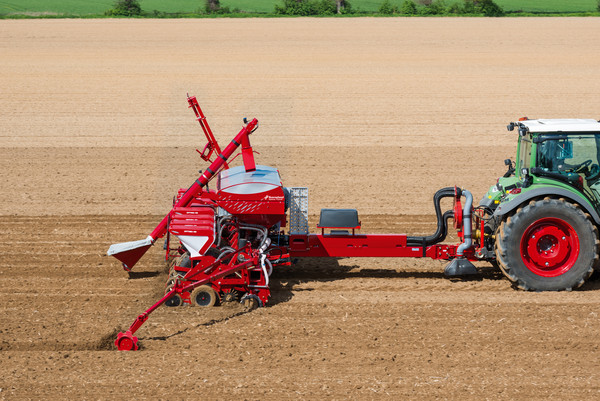
Seeders and transplanters with electronic control of distribution
The greatest versatility and excellent precision for planting seeds and transplanting is no longer achieved with mechanical operations but with the use of electronics
The ongoing reduction of the quotations of agricultural commodity prices due to speculation on global markets is leading to ever increasing risks for profit margins and driving farmers and agricultural machinery manufacturers toward the acquisition of equipment featuring greater efficiency and performance. Though these requirements have repercussions on all operations in the field, what is certain is that behind successful crops is the uniformity of seeding and transplanting for depth and the regularity of spacing along the row is essential for favoring sound growth of the plants.
For this reason, many investments in the sector are made for seeding and transplanting machinery which has evolved beyond the typically simple and totally mechanical models to attain better performance thanks to equipping these machines with electronic devices for work with a level of accuracy and precision which was inconceivable only a few years ago.
The exception for traditional seeders is their use mainly for planting cereals and straw, crops for which row spacing is not essential due to the tillage capability for these cultivations. However for what is called precision or single-seed sowing or for transplanters, the ability to achieve rigorous spacing along the row or between the rows is basic for the optimum development of the crop, for combating weeds and higher resistance against water and nutrition stress.
New electric solutions
For sowing operations, precision machines differ as regards their use of mechanical or pneumatic seeders. In any case, up until a few years ago their operations were exclusively mechanical with the use of chains or, more rarely, small cardan shafts driven by one or more wheels on the machine. It was necessary to modify the ratio between the wheel transmission and the seeding unit by using the speed gearbox to vary the spacing along the rows. This system worked well for decades even though a large number of gears and power changes were needed to modify the density of seeding. These components were sensitive and required frequent control and periodic maintenance. Moreover, the torque needed to running the seeding unit caused inevitable slippage of the power wheel on the terrain which, in relation to the number of seeding units mounted, increased due to lack of traction on heavy or wet soil.
To solve these problems, small usually brushless electric motors can be put to use for the direct operation of one or more seeding units for more accurate and quick variation of the spacing of sowing along the row to allow continuous control via a dedicated CPU, an ISObus compatible central processing unit mounted on the machine.
In this case, the motor rotation regime, and that of the seeding unit, is regulated according to the speed of the advance of the machine recorded by the high precision GPS on the tractor to closely control seeding in proportion to the advance to maintain uniform spacing of the seeds.
Though these motors require dedicated connection, the electric solutions makes it possible to reduce the overall weight of the machine and those limit soil compaction, an important advantage for operations in the seedbed. Moreover, mechanical connections with the various seeding units allows a simple design of folding or telescopic machines to lower bulk for transport.
Furthermore, with the use of electricity, the work of any single seeding unit can be interrupted instantaneously by stopping the single corresponding motor and also simplifies quincunx seeding thanks to the synchronization of the rotation of the various electric motors.
Need for strong current
Each brushless motor requires slightly less than 100 W which means that a classic 6 row seeder needs connections of 12 V so the 40-50 maximum current provided by the tractor is not sufficient for the total power needed.
Thus the power necessary to operate the seeder must include a generator run mechanically off the tractcor PTO and possibly a backup battery.
For transplanters with transplant units consume much more power and an auxiliary generator is mounted on models for two row models.








